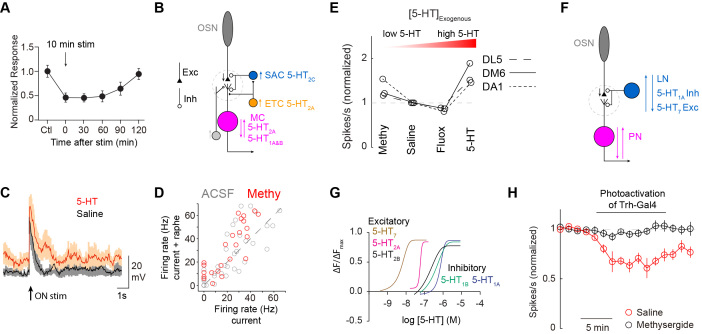Figure 2.
Cellular mechanisms for 5-HT modulation in the OB and AL (A). Strong raphe stimulation results in long-term suppression of OSN output. Adapted from Petzold et al. 2009 with permission. (B). 5-HT acts on several cells in the OB. It directly excites ETC which in turn excite SACs. SACs are also directly excited by 5-HT. These two mechanisms serve to indirectly inhibit OSN axons and thus mitral cell activity. However, 5-HT can also excite MC directly or indirectly through ETC. Thus, the net effect of 5-HT on mitral cells can be either excitatory or inhibitory in a glomerulus specific fashion. (C). Exogenous application of 5-HT boosts mitral cell responses to olfactory nerve shock and suggests a net excitatory role for 5-HT in the OB. Note that the boosting is only seen in absolute terms and that the change from baseline is similar in saline and 5-HT. Adapted from Brill et al. 2016 with permission. (D). However, blocking 5-HT signaling from the raphe with methysergide (methy, 50 μm) boosts other mitral cell responses to current injection showing that 5-HT can have a net inhibitory effect on OB output as well. Compare number of gray and red responses below the unity line. Adapted from Kapoor et al. 2016 with permission. (E). In flies, 5-HT modulates PN output in a non-monotonic fashion where low 5-HT levels suppress output and high 5-HT levels boost PN output. Adapted from Zhang et al. 2016 with permission. (F). A schematic of the AL circuitry that can explain the non-monotonic nature of 5-HT modulation in insects. Inhibitory LNs (blue) possess both excitatory and inhibitory 5-HT receptors. GABAergic LNs typically inhibit OSN output but can also target post-synaptic PNs. (G). Excitatory 5-HT7 and 5-HT1 receptors have greater sensitivity to serotonin than the inhibitory receptors in Drosophila. Thus, low levels of 5-HT may preferentially boost LNs to suppress PN output, while high 5-HT levels may inhibit LN activity and boost PN output. Methysergide would remove excitation to LNs from resting 5-HT levels, thus dis-inhibiting OSN-PN odor responses. Adapted from Gasque et al. 2013 with permission. (H). Optogenetic stimulation of the Trh-Gal line (which does not label the CSDn) inhibits DA1-PN odor responses. Suppression of DA1-PN output requires sustained Trh-Gal4 activation. Adapted from Zhang et al. 2016 with permission.

